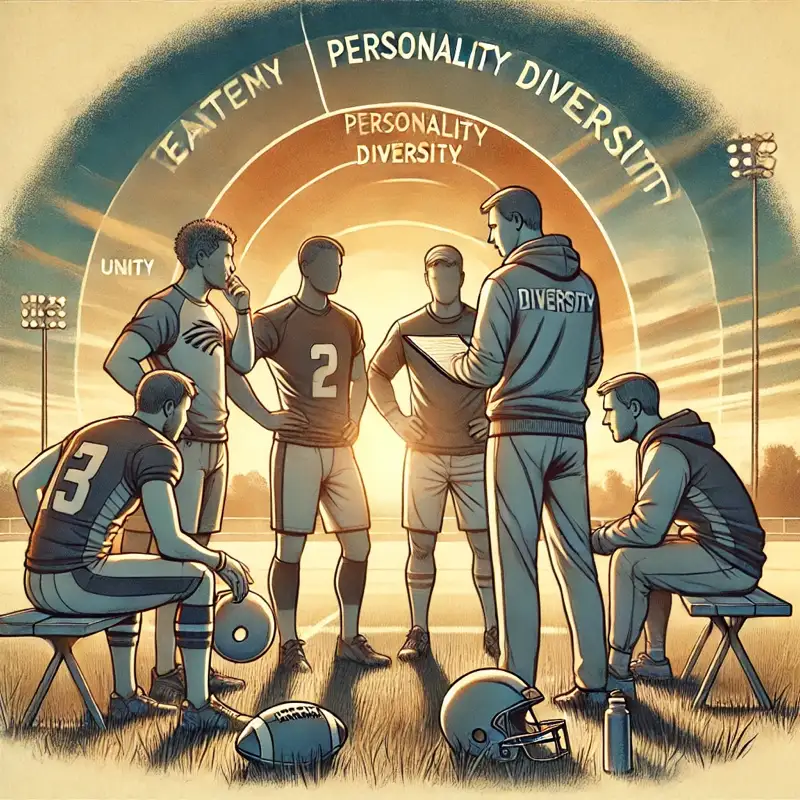
Enhancing Team Performance Through Understanding of Personality Traits
3 min read
Enhancing Team Performance Through Understanding Big Five Personality Traits
In team sports, cooperation and understanding among athletes are crucial for success. By using the Big Five personality test, team members can gain insight into each other’s personality traits, strengthening communication, trust, and efficiency on the field. The Big Five model assesses five key dimensions: Openness, Conscientiousness, Extraversion, Agreeableness, and Neuroticism. Understanding these traits can help teams adjust strategies and roles to maximize performance.
The Importance of Personality in Team Sports
Research shows that personality traits influence how athletes interact and perform in a team. A study by Martinsen (2017) at the Norwegian School of Sport Sciences highlights that elite athletes often share certain psychological characteristics, such as high Conscientiousness and low Neuroticism, which contribute to their success. By identifying and understanding these traits within a team, coaches and athletes can develop better collaboration strategies and tailor training to meet individual needs.
Practical Exercises for Different Age Groups
Below are three tailored exercises for integrating Big Five awareness into team sports, designed for children, teenagers, and elite athletes.
1. Children (Ages 6-12)
Objective: Promote understanding of individual differences and strengthen teamwork skills.
Exercise: “The Strength Flower” (15 minutes)
Preparation: The coach draws a large flower on a whiteboard or poster, with five petals representing the five personality traits.
Execution:
- Briefly explain what each petal represents in a simple, child-friendly way.
- Ask each player to think about what “strength” they bring to the team (e.g., “I come up with new ideas” for Openness or “I am always on time for practice” for Conscientiousness).
- Each player writes their name on a sticky note and places it on the petal they feel best represents them.
- Discuss as a group how these strengths contribute to the team’s success.
Benefits: This exercise helps children recognize and appreciate both their own and their teammates’ contributions, fostering a supportive team environment.
2. Teenagers (Ages 13-18)
Objective: Increase self-awareness and understanding of how personality influences team dynamics.
Exercise: “Personality and Position” (15 minutes)
Preparation: The coach prepares a short description of the five personality traits and how they relate to different roles on the team.
Execution:
- Divide the team into small groups of 3-4 players.
- Give each group a description of the five personality traits.
- Ask them to discuss and identify which trait they believe is most dominant in each player in their group.
- Discuss as a team how different traits can suit various positions or tasks on the field and how they can be utilized strategically in gameplay.
Benefits: This exercise encourages reflection on both individual and team strengths, helping players understand how personality can be leveraged for better team performance.
3. Elite Athletes & National Teams
Objective: Fine-tune team dynamics and optimize performance through deeper personality awareness.
Exercise: “Strategic Role Allocation” (15 minutes)
Preparation: The coach reviews previously conducted Big Five test results to gain an overview of the team’s personality composition.
Execution:
- Present an anonymous summary of the team’s collective personality traits.
- Discuss how the dominant traits may influence playing style, communication, and stress management.
- Identify any gaps or imbalances in personality distribution and discuss strategies to compensate for them, whether through tactical adjustments or mental training.
Benefits: This exercise provides insight into how the team’s overall personality influences performance and helps inform strategic decisions to optimize team cohesion.
Conclusion
Integrating the Big Five personality test into team sports can provide valuable insights into both individual and collective strengths and challenges. By understanding and appreciating these differences, teams can improve communication, adapt strategies, and strengthen cohesion, ultimately leading to better performance on the field.